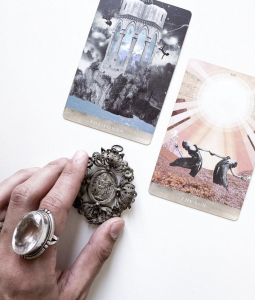Feng Shui Basics

An Introduction to Feng Shui
Feng Shui is one of the eight limbs of Chinese medicine. How can we heal when we are in a chaotic or messy environment? A calm, peaceful environment helps us to rest, relax, and restore our vital energies. All eight limbs of Chinese medicine work together to create good health: feng shui, astrology, herbology, exercise (tai chi, chi kung), meditation, diet, massage, and acupuncture. We can create a balanced home, landscape, and workplace by applying feng shui principles of balance and harmony.
Historical Prespective
Everywhere on our planet - from the pyramids in Egypt, to the monoliths of Stonehenge in England, to the Ming tombs in China - ancient people honored sacred places. Mountains, rivers, hills, and groves, or places where natural phenomenon occurred, indicated a sacred place.
Feng shui (pronounced "fung shway") is an ancient Chinese art and science of locating a sacred place on earth. The literal translation of feng shui is "wind" and "water", two elements of nature. The ancient Chinese people developed feng shui based on their unique spiritual view of the world. They studied nature to make sense of the universe. In nature they sensed "chi"energy, the breath of life in all things. They understood the harmony of life by observing nature and being expert intuitives. The ancient ones recognized chi in a landscape to determine which locations would be safe from danger, provide lush vegetation, and align harmoniously with the geomagnetism of the earth.
Taoism
The philosophy of the balance of nature became the spiritual philosophy of Taoism (pronounced "Dowism"). Priests of Taoism, who were both female and male, discovered and developed feng shui geomancy through observation of land forms, river flows, movement of planets, behavior of animals, and changing weather conditions. Feng shui concerns of the early Taoists were when to cultivate crops, how to irrigate with the flooding rivers, and where to construct villages, buildings, and tombs.
The ancient Taoists observed that humans live where earth meets heaven, in the middle of these two great forces, in the "Middle Kingdom." The ancient Chinese invented the magnetic compass and correlated the following mythological animals to each of the four directions:
- From the south we receive warmth, heat, and vitality. The symbolic animal of the south is the red phoenix, which represents beauty and goodness.
- From the North comes cold, snow, and darkness. North's symbolic animal is the black tortoise, which represents long life and endurance.
- The direction east corresponds to springtime, blue seas, and new growth. East's symbolic animal is the azure dragon, which represents majesty and magnificence.
- The direction west corresponds to autumn and snowy mountains. West's symbolic animal is the white tiger, which exemplifies bravery and strength.
Five Elements
A way to create order out of chaos is the divide the cosmos into elements.
The ancient Taoists understood the unity of all things as created from the five Taoist elements of fire, earth, metal, water, and wood. These five elements are used in feng shui to balance and create harmony.
- Fire - In traditional Chinese medicine, fire corresponds to the heart. The fire room of feng shui is the living room, the heart of the home.
- Earth - The element earth corresponds to the stomach in Chinese medicine, and the dining room in feng shui, since this is the room where food is eaten and digested.
- Metal - In Chinese medicine, metal corresponds to the lungs. In feng shui, the bedroom is the metal room, where we sleep and breathe deeply at night.
- Water - The element water corresponds to the kidneys in Chinese medicine, so it makes sense that the water room in feng shui is the bathroom.
- Wood - The element wood corresponds to the liver in Chinese medicine and the kitchen in feng shui, where wood is added to the fire for cooking.
Yin and Yang
An interpretation of yin and yang in a landscape is that mountains are yang and valleys are yin. An interpretation of yin and yang in architecture is that yin buildings house the dead and yang buildings house the living. Yin and yang balance applies to interior spaces. An excessively yin room is dark, damp, and poorly lit. Such an environment can evoke feelings of sadness. An excessively yang room is too bright or over lit. It can evoke feelings of anxiety. When balanced, yin and yang are appropriately applied to interior spaces. For example, a bedroom is a quiet yin room for sleep, yet a living room is a yang room for lively conversation and activity, for "living."
Eight Trigrams
The eight trigrams in Chinese are ba-gua, pronounced "bah gwah." Ba means eight and gua means trigram. A trigram is a symbol made of three lines stacked on top of each other. A solid line represents yang chi. A broken line represents yin chi. The ba-gua can be applied as a feng shui template over a room, building, site, or landscape. Trigrams represent elements of nature: fire, earth, lake, heaven, water, mountain, thunder, and wind.
These eight tri-grams can be applied to a room, building, or landscape: The fire location represents fame and reputation; the earth location represents relationships; the lake location represents children and creativity; the heaven location represents travel and assistance; the water location represents career; the mountain location represents self knowledge; the thunder location represents health and family; and the wind location represents wealth.
Yin/Yang Cosmology
According to the ancient Taoists, all energy is interconnected. This connection, the Tao, is symbolized by the interwoven circle of Yin and Yang.
Traditionally, yin is the dark, feminine, and receptive principle. Yang is the light, masculine, and active principle. Together, yin and yang flow endlessly into each other. Each creates and defines the other's opposite.
Yin and yang are relative to each other and are in a constant state of flux.
For example, because of the existence of dark, the concept of light has meaning. Similarly, high is defined by low, and sweet is defined by sour. In Western thought, the balance of yin and yang could be interpreted as conflicting opposites. Yet in Taoist thought there is not duality but unity.
Yin and yang remain the natural order of the universe because the yin and yang cycle constantly repeats. For example, high noon, the most yang hour, progresses to midnight, the most yin hour. Summer solstice, the longest day, is the most yang time of the year. It progresses to winter solstice, the longest night, which is the most yin. Even in our bodies we experience the endless dance of yin and yang. When we inhale, our lungs expand to the most yang point, and when we exhale they contract to the most yin point.
Therefore, at the height of yang, yin ascends and yang declines. At the height of yin, yang ascends and yin declines. Death occurs when yin and yang separate.
The interplay of yin and yang are described in the verses by the Taoist philosopher Lao-Tzu, born in 604 B.C. Lao-tzu distilled Taoist wisdom into eighty-one short chapters of verse in his classic book the Tao Te Ching. He explains the harmonious yet dualistic principles of the Tao:
Thirty spokes join together in a single wheel, but it is the center hole that makes the wagon move.
- We shape a lump of clay into a vessel, but it is the emptiness inside the vessel that makes it useful.
- We hammer doors and windows of wood for a house, but it is the empty inner space that makes the rooms livable.
- We build with the tangible, but the intangible is what we use.
Unlock relationship secrets with a Keen Advisor - your first 3min FREE!










